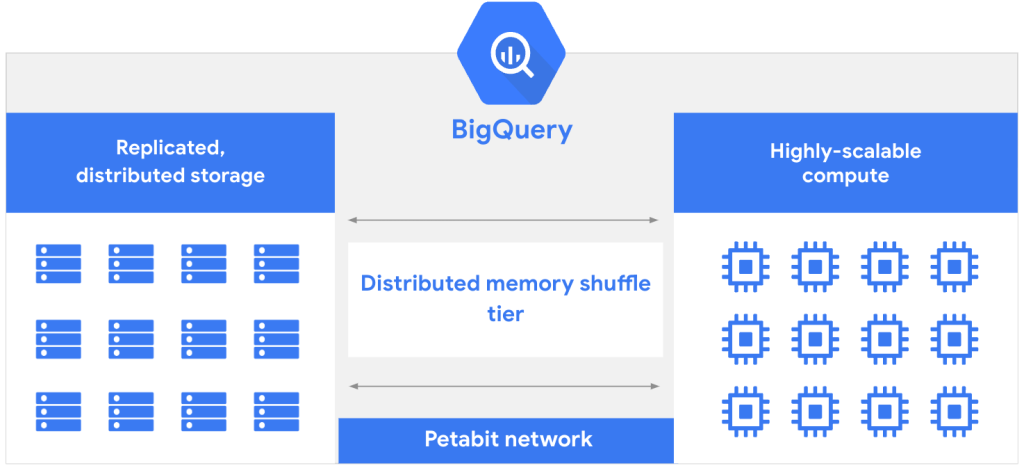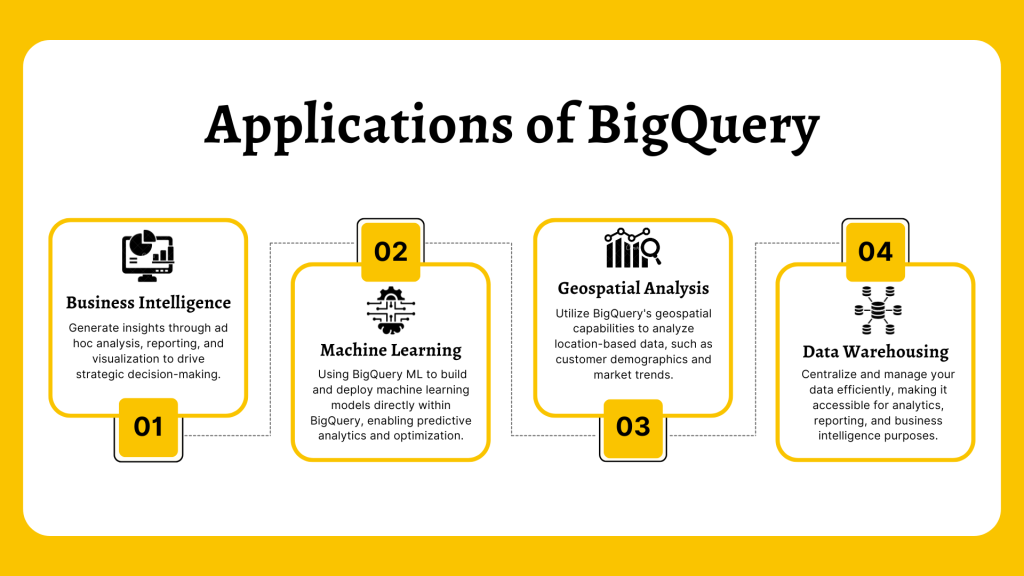Why BigQuery is the Best Enterprise Data Warehouse?
Google Cloud Platform’s BigQuery stands out as a beacon of efficiency and scalability in this era. By providing a fully managed solution that handles the complexities of data storage, processing, and analysis, BigQuery liberates organizations from the burden of managing infrastructure and allows them to focus on deriving actionable insights from their data.
With its serverless architecture, petabit-scale network, and support for federated queries, BigQuery empowers organizations to break through the limitations of traditional data warehouses and unlock the full potential of their data. Whether it’s performing ad hoc analysis, building machine learning models, or conducting geospatial analytics, BigQuery offers a comprehensive suite of tools and features to meet the diverse needs of modern businesses.
As the volume and complexity of data continue to grow, the role of data warehousing in driving business success will only become more pronounced. With BigQuery leading the charge, organizations can confidently navigate the complexities of data management and analytics, secure in the knowledge that they have a powerful ally in their quest for data-driven excellence.
Architecture Overview

BigQuery’s architecture comprises two main components: the storage layer and the compute layer. The storage layer ingests, stores, and optimizes data, while the compute layer provides powerful analytics capabilities. What sets it apart is its separation of these layers, allowing each to dynamically allocate resources independently. This separation principle enables rapid innovation and ensures minimal downtime during updates and maintenance.
What is Data Warehousing
Before delving into the specifics of BigQuery, it’s essential to grasp the concept of data warehousing. A data warehouse is a centralized repository that stores structured, historical data from various sources within an organization. Unlike operational databases optimized for transactional processing, data warehouses are tailored for analytical queries and reporting, making them invaluable for extracting insights and trends from large datasets. Data warehousing involves processes such as data extraction, transformation, loading (ETL), and querying to facilitate robust analysis and decision-making.
Data Warehousing with BigQuery
BigQuery stands out as a premier enterprise data warehouse within the realm of cloud computing. Leveraging Google’s infrastructure and expertise, BigQuery offers a fully managed, serverless architecture that eliminates the need for organizations to manage infrastructure overhead. This serverless model allows users to focus solely on data analysis without concerning themselves with provisioning, scaling, or maintenance tasks traditionally associated with on-premises data warehouses.
At the core of BigQuery’s architecture lies its separation of compute and storage layers, a design principle that enables seamless scalability and performance optimization. By decoupling these layers and leveraging Google’s petabit-scale network, BigQuery can dynamically allocate resources for compute-intensive analytical queries while ensuring high availability and reliability of stored data.
Furthermore, BigQuery’s support for federated queries enables users to seamlessly integrate and analyze data from external sources, extending the platform’s capabilities beyond internal datasets. This feature facilitates real-time analysis and insights generation by allowing continuous data updates from diverse sources.
Advantages of BigQuery
- Scalability: BigQ’s distributed analysis engine empowers users to query massive datasets within seconds, enabling rapid insights generation even at petabyte-scale.
- Serverless Architecture: With BigQ’s serverless model, organizations can offload infrastructure management tasks to Google, freeing up resources to focus on data analysis and innovation.
- Federated Queries: The ability to query data from external sources seamlessly enhances data integration capabilities, enabling comprehensive analysis across disparate datasets.
- Built-in Features: BigQ’s integration with machine learning, geospatial analysis, and business intelligence tools augments its analytical capabilities, allowing users to derive deeper insights from their data.
- Cost Efficiency: BigQ’s pricing model, which is based on a pay-as-you-go basis, ensures cost efficiency by charging users only for the resources they consume, thereby eliminating the need for upfront investments in infrastructure.

Conclusion
In conclusion, Google Cloud Platform’s BigQuery represents a paradigm shift in the realm of data warehousing, offering organizations a fully managed and scalable solution to tackle the challenges of data management and analytics. With its powerful features, including machine learning integration, geospatial analysis, and support for federated queries, it enables organizations to extract actionable insights from their data assets with unprecedented speed and efficiency.
By embracing BigQuery, organizations can streamline their data workflows, accelerate decision-making, and drive innovation across all facets of their operations. The platform’s serverless architecture and seamless integration with Google Cloud’s infrastructure alleviate the complexities of traditional data warehousing, allowing organizations to focus on what matters most: leveraging data to gain a competitive edge and fuel growth.








